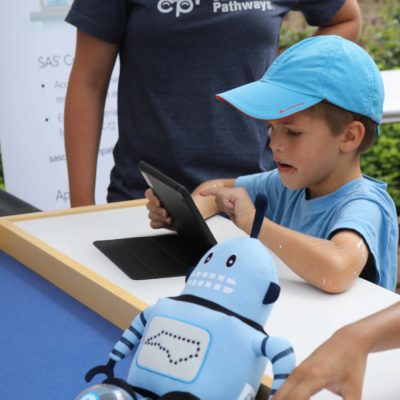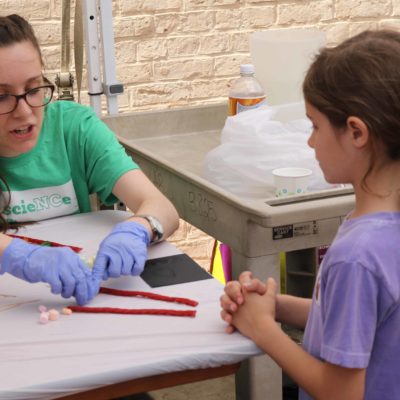

What combination of extremophiles and meteorite shields would produce the highest resistance from radiation?
Ana Sofia Uzsoy, a senior at the North Carolina School of Science and Mathematics (NCSSM), patiently explained what this question meant, how she tackled it, and the answers, to person after person on Saturday at the 2017 UNC Science Expo.
Uzsoy spent three 10-week trimesters to find a conclusion that supports the possibility of human life underground on Mars. She said she has explained her work so many times that her speech flows almost without effort.
“I could talk about it without even thinking about it,” Uzsoy said. She was one of many scientists, graduate students, researchers, educators, and science advocates who shared their work and their passion with children over the weekend.
Todd Boyette directs of the Morehead Planetarium and Science Center which produced the expo along with The University of North Carolina at Chapel Hill and the Town of Chapel Hill. The science expo is a signature event — among more than 400 other science-themed events statewide — of the multiple-week North Carolina Science Festival. The event drew thousands.
Boyette said Saturday was the seventh science expo of its kind, and, he expected, the most successful yet. The expo combined informative tents with physical activities, arts and crafts, live science shows, and performers like the jump-roping Bouncing Bulldogs to entertain, educate, and engage.
Boyette said the planetarium worked with more than 100 exhibitors to make their expert information accessible and fun for kids and their families.
“They bring the content. We refine, simply, the delivery method,” Boyette said. He told exhibitors to think about what appeals to their family members, to their children or their nieces and nephews, or to their grandparents. The more interaction, the better. The more senses a participant can use to access the information, the better.


The most important part of getting young people excited about science, technology, engineering, and math, Boyette said, is the human connection between a scientist and a child.
“At an expo like this is, you’re right there,” he said. “You’re right across the table. You’re with a scientist who’s in the lab doing the work that we read about in the papers.”
Boyette said average people are more supportive of scientific work and are able to more easily understand its applicability when they meet the person behind the research and hear the information from the source.
“What we’ve discovered through doing these kinds of events is that whenever you get a scientist engaged with a member of the general public, good things happen,” Boyette said. “Good things happen for the public, good things happen for scientists.”
He said scientists have reported they feel more passionate about their work after having engaged with people who are interested in what they have to share.
Children and their families went from tent to tent to learn about everything from how to program a spherical robot to travel across a table to reach a stuffed animal, to how energy from a light source can create a chemical reaction and change the color of a small tube of dyed water.


Elizabeth Martin, a PhD student at UNC-Chapel Hill’s Gillings School of Global Public Health, hosted a tent, along with her team, on the levels of arsenic in water from private wells across North Carolina.
She helped children create a meal, asking them to make choices between wild-caught or farm-raised catfish, and tap or well water. She then explained why the decision they made was a healthier one or not.
And in a plastic tub full of rice, Martin had kids look for one red grain of rice in “a billion” white grains of rice. She said she wanted to show, how, when it comes to toxic elements in food or drinking water, “one small amount can still make a big difference in the long term.”
She demonstrated how, with two glasses of water containing blue food coloring, one larger and one smaller, the same level of arsenic can have a greater affect on smaller bodies. She said the difference is why her team worries the most about the impact unsafe water can have on children and women.
Boyette said he believes interactions like the one Martin had with hundreds of kids on Saturday are vital.
“The more opportunities we can provide to get researchers, faculty, graduate students, interacting with members of the public,” he said, “then the better off we’ll be.”








